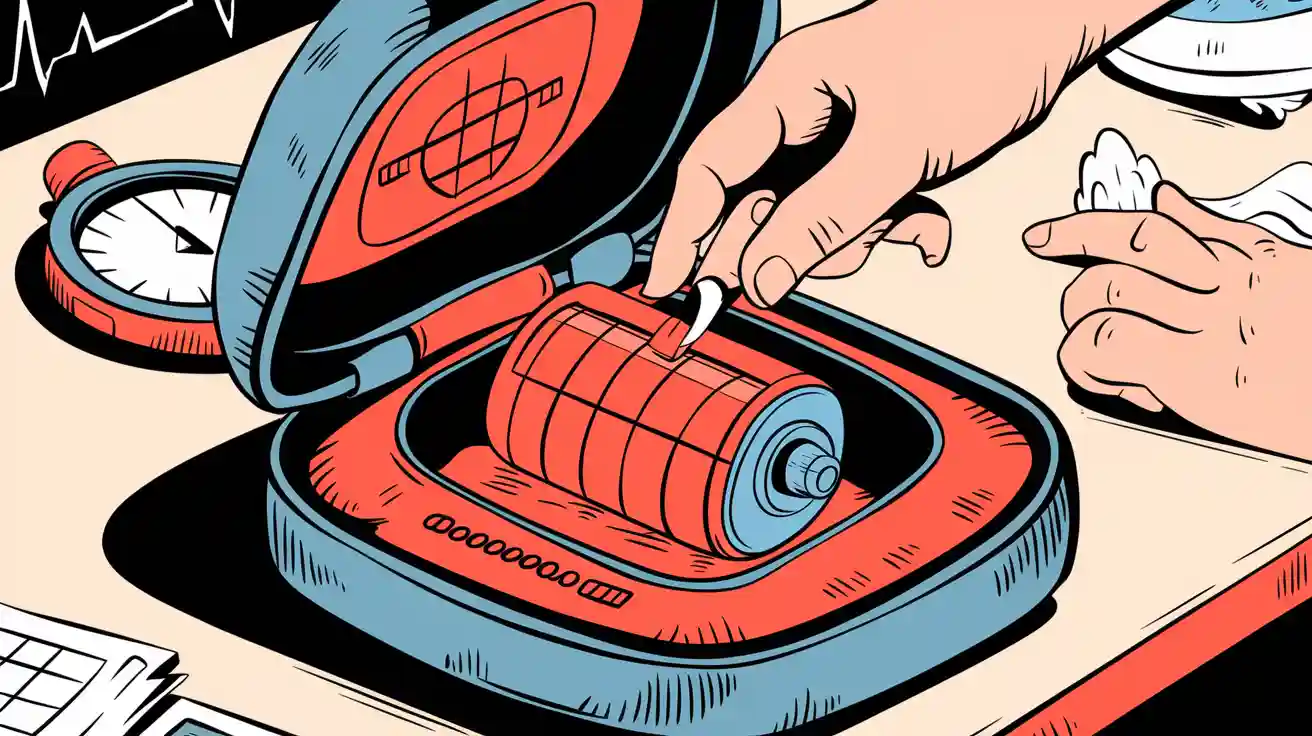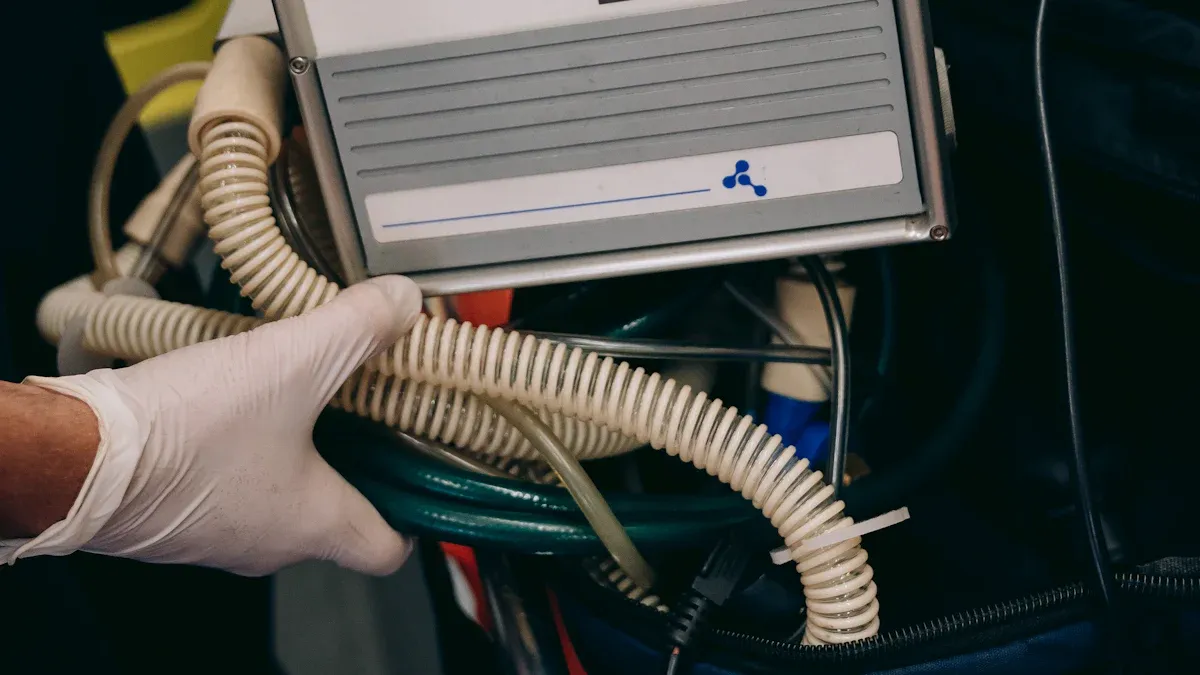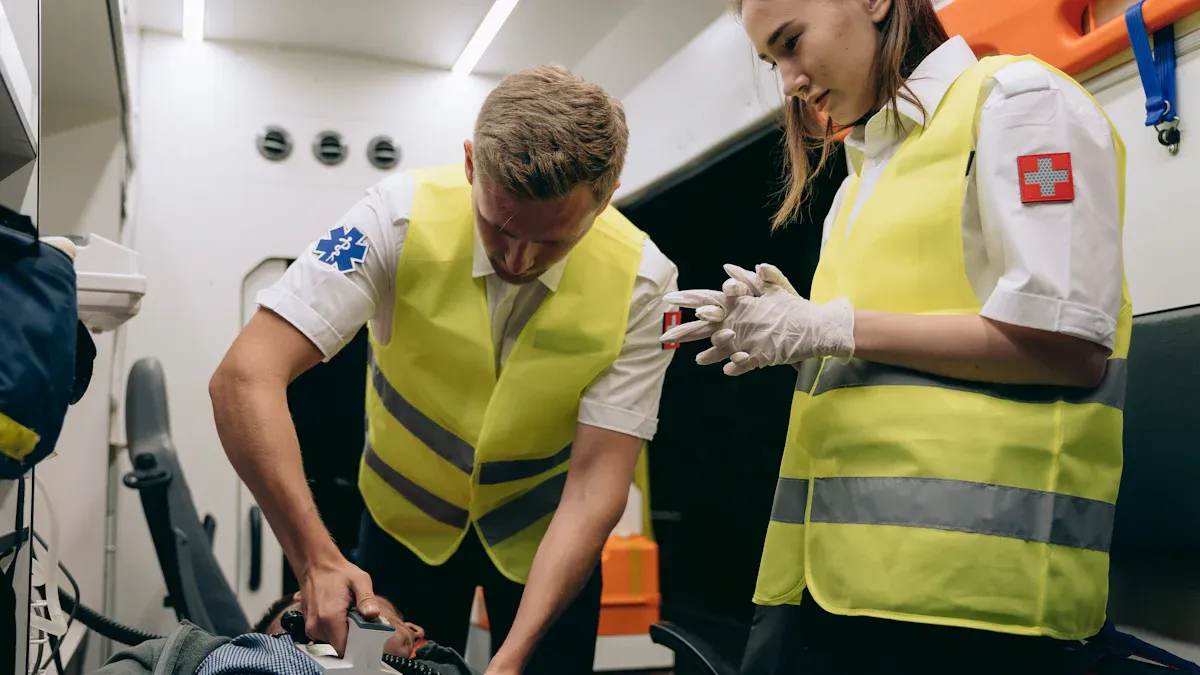
When you deploy an automated external defibrillator in a critical emergency, battery performance directly impacts survival. Consider this: patients who receive an AED before emergency medical services arrive have a 64% survival rate, compared to just 47% without AED intervention.
Time to AED Use | 30-Day Survival Rate |
|---|---|
AED used before EMS arrival | 64% |
No AED used | 47% |
Lithium battery technology offers reliability, high energy density, and a long shelf life. You benefit from low self-discharge rates and consistent operation in varied environments, ensuring your AEDs stay ready for immediate use.
Key Takeaways
Battery performance is crucial for AED effectiveness. Using an AED before emergency services can increase survival rates to 64%.
Lithium batteries are the best choice for AEDs due to their high energy density, long shelf life, and low maintenance needs.
Regularly check and replace AED batteries to prevent device failure. Most batteries last 2-5 years, so proactive management is essential.
Ensure your AED is always ready by following best practices for maintenance, including routine inspections and proper storage.
Training staff on AED use and conducting regular drills can significantly improve emergency response and patient outcomes.
Part 1: Automated External Defibrillator Battery Basics

1.1 Lithium Battery Technology
You rely on lithium battery technology to power your automated external defibrillator in critical moments. Lithium batteries deliver high energy density, lightweight construction, and long shelf life, making them the preferred choice for AEDs in medical, security, and infrastructure environments. These batteries store more energy in a compact form, which ensures your AED remains portable and ready for rapid deployment during sudden cardiac arrest or arrhythmias.
Tip: Lithium thionyl chloride batteries can operate maintenance-free for up to 40 years, but most AEDs use lithium manganese dioxide or lithium sulfur dioxide for optimal balance between energy density and pulse delivery.
Here’s a comparison of common lithium chemistries used in AEDs and other sectors:
Battery Chemistry | Energy Density | Typical Shelf Life | Application Scenarios |
|---|---|---|---|
Lithium Manganese Dioxide (LiMnO₂) | High | 3-5 years | Medical, Security, Robotics |
Lithium Sulfur Dioxide (LiSO₂) | Moderate | 3-5 years | Medical, Industrial |
Lithium Thionyl Chloride (LiSOCl₂) | Very High | Up to 40 years | Infrastructure, Consumer Electronics |
Lithium Iron Phosphate (LiFePO₄) | Moderate | 5-7 years | Industrial, Robotics |
Lithium Nickel Manganese Cobalt (NMC) | High | 5-7 years | Medical, Consumer Electronics |
Lithium Cobalt Oxide (LCO) | High | 3-5 years | Consumer Electronics |
Lithium Titanate (LTO) | Moderate | 10+ years | Industrial, Security |
You benefit from higher energy density, lighter weight, and longer cycle life compared to older battery types. Lithium batteries also retain capacity over time and adapt to a wide temperature range, supporting AED readiness in public access AEDs and professional settings.
1.2 Powering AED Devices
Your AED depends on reliable battery performance to deliver a life-saving shock during cardiac emergencies. Most AED batteries provide a voltage range from 12V to 18V and support over 200 full-energy shocks per charge. The operational lifespan for lithium batteries in AEDs typically ranges from 3 to 5 years, with professional-grade models lasting about 4 years.
You can choose between rechargeable and non-rechargeable batteries based on your operational needs:
Battery Type | Shelf Life | Maintenance Requirements |
|---|---|---|
Non-rechargeable Lithium | 4-5 years | Replace after several years of use |
Rechargeable | 2-3 years | Recharge after each use; follow manual instructions |
Non-rechargeable lithium batteries offer longer shelf life and minimal maintenance, ideal for public access AEDs and remote infrastructure. Rechargeable batteries suit high-use environments, such as hospitals and industrial facilities, where frequent shocks and regular maintenance occur.
Note: Exceeding the recommended shelf life can lead to malfunction during emergencies, impacting device readiness and patient outcomes.
Part 2: Rapid Response in Sudden Cardiac Arrest

2.1 Instant Power Delivery
You face a critical challenge when sudden cardiac arrest strikes. Every second counts. Your automated external defibrillator must deliver a shock immediately to restore normal cardiac rhythm and prevent irreversible damage. Lithium battery packs provide the instant energy required for this life-saving intervention. You benefit from high energy density and rapid discharge capabilities, which ensure your defibrillator can deliver a powerful shock without delay.
AED batteries are engineered to meet strict technical requirements for instant power delivery:
Lithium chemistry offers lightweight construction and long shelf life, supporting readiness in public access AEDs and professional settings.
Each defibrillator model requires a specific battery type. Using the wrong battery can cause malfunctions or damage.
You must monitor expiration dates, check charge levels, and store batteries properly to maintain optimal energy output.
Tip: Always verify that your AED battery matches the manufacturer’s specifications. This step prevents device failure during emergencies and guarantees reliable shock delivery.
You rely on lithium battery packs in medical, security, and industrial environments because they provide consistent energy for multiple shocks. In robotics and infrastructure, instant power delivery supports rapid deployment and operational continuity. You cannot afford delays when arrhythmias threaten lives.
2.2 Minimizing Downtime
Downtime in defibrillator operation can lead to tragic outcomes. You must address battery readiness and reliability to maximize patient survival rates. Most device failures stem from battery-related issues, including expired batteries, low charge, and unexpected power-offs.
Cause of Downtime | Description |
|---|---|
Expired or depleted batteries | Replace batteries proactively based on lifespan, not just warning lights. |
Low battery messages | Indicate the need for maintenance and should be addressed promptly. |
Unexpected power-offs | Can occur due to battery issues, leading to device failure. |
You should note that 54 cases of low battery warnings and 110 instances of unexpected power-offs have been documented. Nearly half of device problems linked to fatalities resulted from insufficiently charged batteries. You must implement strict protocols to minimize downtime and ensure your AED is always ready for use.
Recommended maintenance tasks include:
Inspect electrodes and battery life to confirm components remain within expiration dates.
Manage supply inventory so essential lithium battery packs are available for every defibrillator.
Inspect for defects to identify physical damage that could impair AED functionality.
Conduct functionality testing to verify the AED delivers the required shock and energy during emergencies.
Record maintenance details for accountability and future reference.
Alert: Proactive battery management saves lives. You should never wait for a warning light before replacing batteries. Schedule regular checks and maintain detailed logs to ensure your AED delivers a shock when needed.
You support operational readiness in medical, industrial, and public access AED deployments by prioritizing battery reliability. Consistent energy output and minimized downtime translate directly to improved cardiac outcomes in sudden cardiac arrest and arrhythmias.
Part 3: High Power Output for Defibrillator Performance
3.1 Energy Demands of Defibrillation
You must understand the energy demands placed on your defibrillator during sudden cardiac arrest. When you activate an AED, the device must deliver a shock with enough energy to depolarize the heart muscle and restore normal rhythm. Most AEDs for adults deliver between 150 and 360 joules per shock, with many models programmed for 120-200 joules. For example, the Avive Connect AED delivers a 150 joule shock to adult patients. This high energy output is essential for effective defibrillation and successful cardiac outcomes.
Adult AEDs typically deliver 150-360 joules per shock.
Pediatric guidelines recommend an initial dose of 2 J/kg, escalating to 4 J/kg if the first shock fails.
The European Resuscitation Council recommends 4 J/kg for pediatric patients, emphasizing the need for higher energy in some cases.
Your AED must provide instant, reliable energy to meet these demands. Lithium battery packs support this requirement by offering high power density and rapid discharge rates. You benefit from standardized lithium chemistries, such as lithium manganese dioxide and lithium sulfur dioxide, which ensure consistent energy delivery for every shock. These batteries perform reliably in medical, industrial, and security environments, where downtime is not an option.
Note: The minimum power output required for effective defibrillation can reach up to 8 kW during the brief discharge period. Your AED battery must handle this peak demand without compromising safety or reliability.
3.2 Consistent Output and Safety
You rely on your AED to deliver consistent energy output for every shock, regardless of patient size or impedance. Consistency in power delivery is critical for patient safety and device performance. Variations in output can lead to failed shocks, increased risk of arrhythmias, or poor cardiac outcomes.
Key Factors | Description |
|---|---|
The energy delivered to myocardial cells determines the success of defibrillation and impacts survival rates. | |
Defibrillation Threshold | Higher impedance can increase the defibrillation threshold, requiring more energy for effective shocks. |
Recommendations | ERC guidelines advise using maximum energy settings when device settings are unknown, ensuring adequate delivery. |
You must monitor battery health and replace lithium battery packs before they reach end-of-life. This practice ensures your AED delivers the required shock every time. Standardized lithium chemistries provide stable voltage and current, supporting consistent output in medical, robotics, and infrastructure applications.
Alert: Always follow manufacturer guidelines for battery replacement and testing. Inconsistent energy delivery can compromise patient safety and reduce survival rates in sudden cardiac arrest.
You support operational readiness by choosing high-quality lithium battery packs for your AEDs. These batteries maintain performance across multiple shocks and varied environments, from hospitals to industrial sites. You minimize risk and maximize patient outcomes by prioritizing consistent, reliable energy delivery.
Part 4: AED Battery Reliability and Maintenance
4.1 Monitoring and Replacement
You must prioritize regular monitoring and timely replacement of AED batteries to ensure your defibrillator delivers a shock when needed. Battery failure accounts for 25% of automated external defibrillator malfunctions, which has contributed to over 1,000 cardiac arrest deaths in the past 15 years. Most AEDs use lithium battery packs, which typically last two to five years, but you should never rely solely on expiration dates or warning lights.
Setting | Recommended Interval |
|---|---|
Clinical Areas | Daily inspections required |
Public Areas | Weekly checks recommended |
Organizational Settings | Monthly comprehensive reviews |
Professional Maintenance | Annual inspections recommended |
You should always check battery expiration dates, respond promptly to low battery warnings, and keep spare batteries available. Replace batteries immediately when you see a low battery indicator or hear a warning beep. Follow the manufacturer’s instructions for battery replacement to prevent device failure during a cardiac emergency.
Environmental factors also impact battery reliability. Extreme heat, cold, or high humidity can shorten battery life and reduce the energy available for a shock. Store your AED within the recommended temperature range of 50°F to 86°F to maintain optimal performance.
Tip: Maintain a detailed log of all inspections and battery replacements. This practice ensures compliance with legal requirements and supports continuous readiness for life-threatening arrhythmias and shockable rhythm events.
4.2 Best Practices for Readiness
You can maximize AED readiness by following industry best practices:
Identify and document the location of each AED and its supplies.
Assign responsibility for regular inspections and establish a routine schedule to check readiness indicators and expiration dates.
Track and document all battery and pad replacements, as well as any repairs.
Ensure hardware, charged batteries, and unexpired pads are always operational.
Stay informed about regulatory requirements to avoid legal penalties.
Provide ongoing training for staff to build confidence in AED use and reduce user errors.
Organizations often face a choice between rechargeable and non-rechargeable batteries. Non-rechargeable lithium batteries are more common and require less frequent maintenance, making them ideal for public access and low-use environments. Rechargeable batteries, used more often in hospitals and high-traffic areas, require downtime for charging and higher upfront costs due to charging equipment.
Battery Type | Maintenance Needs | Replacement Frequency | Application Scenario |
|---|---|---|---|
Non-rechargeable | Low | Every 2-5 years | Public access, infrastructure |
Rechargeable | Moderate to High | Every 2-3 years | Hospitals, industrial sites |
You should also consider the cost of maintaining each AED. The annual maintenance cost is about $40 per device, with additional expenses for training and each use. Keeping your AEDs ready for a shock at any time helps protect lives and supports your organization’s commitment to safety.
Alert: Regular inspections, prompt battery replacement, and proper storage conditions are essential for reliable defibrillator performance and successful cardiac outcomes.
Lithium battery packs give your defibrillator the rapid response and high power output needed for cardiac emergencies. You improve reliability by selecting high-quality batteries and following best practices for maintenance. Recent studies show that managing heat dissipation and using smart design features can extend device life, especially in demanding environments.
Assign a dedicated person to maintain each AED.
Use checklists, inspect battery life, and document all maintenance.
Conduct regular drills and provide hands-on training for staff.
Training Approach | Impact on AED Use and Cardiac Outcomes |
|---|---|
Boosts knowledge, confidence, and emergency response |
Regular checks and staff education ensure your AED is always ready to save lives.
FAQ
What type of battery does an AED use?
You use lithium battery packs in most AEDs. These batteries provide high energy density and long shelf life. They support reliable shock delivery in medical, security, and industrial environments.
How often should you replace an AED battery?
You should replace your AED battery every two to five years. Always check the expiration date and perform regular inspections. This practice ensures your defibrillator delivers a shock when needed.
Can you use rechargeable batteries in an AED?
You can use rechargeable lithium batteries in some AED models. Hospitals and industrial sites often choose this option. Rechargeable batteries require more frequent maintenance but support high-use scenarios where the defibrillator may deliver multiple shocks.
What happens if an AED battery fails during an emergency?
If your AED battery fails, the device cannot deliver a shock. This failure can lead to poor outcomes in sudden cardiac arrest. You must monitor battery status and replace batteries before they expire.
Why is instant power delivery important for AEDs?
Instant power delivery ensures your AED can deliver a shock without delay. Lithium battery packs provide rapid discharge, which is critical for restoring heart rhythm in emergencies across medical, robotics, and infrastructure settings.




